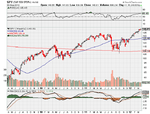The purpose of the journal is to demonstrate the profitability of my hybrid system/methodology. The system is traded on the S&P500, although it could be any index, Dow, NASDAQ, etc. The purpose of using an index is to simply eliminate individual stock risk, and retain market risk.
This essentially consists of two separate strategies that run together in a single portfolio. One is a constant, always in the market methodology, and in the early days, which this still is, may well result in a drawdown. The second component is a purely timing component, based on a weekly signal.
Strategy #1 seeks to build a compounding position, suitable to fund a retirement at some point, while the swing component, strategy #2, simply seeks to accelerate that process.
The hybrid strategy has been tracked fro the last 10 weeks. I use the various tools at m@arketocracy to track all the transactions. This has several advantages: they provide an accounting of all trade metrics, entries/exits/dividends paid/profit/loss/etc. It saves a tremendous amount of time rather than doing it all by hand.
Second, it prevents cheating. All the metrics are kept by m@rketocracy, therefore providing the accounting of an independent third party, always useful in the trading game.
I'll have this weeks results posted a little later.
jog on
duc
This essentially consists of two separate strategies that run together in a single portfolio. One is a constant, always in the market methodology, and in the early days, which this still is, may well result in a drawdown. The second component is a purely timing component, based on a weekly signal.
Strategy #1 seeks to build a compounding position, suitable to fund a retirement at some point, while the swing component, strategy #2, simply seeks to accelerate that process.
The hybrid strategy has been tracked fro the last 10 weeks. I use the various tools at m@arketocracy to track all the transactions. This has several advantages: they provide an accounting of all trade metrics, entries/exits/dividends paid/profit/loss/etc. It saves a tremendous amount of time rather than doing it all by hand.
Second, it prevents cheating. All the metrics are kept by m@rketocracy, therefore providing the accounting of an independent third party, always useful in the trading game.
I'll have this weeks results posted a little later.
jog on
duc
















